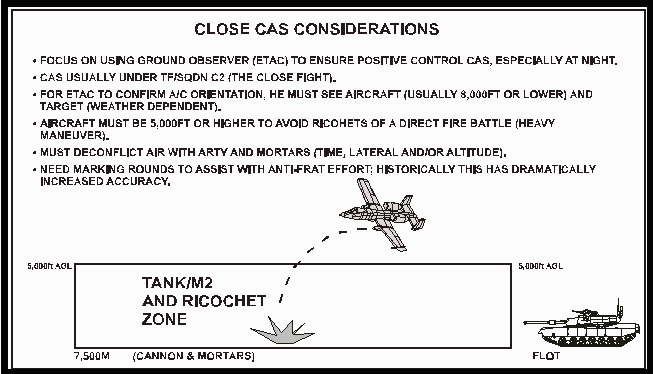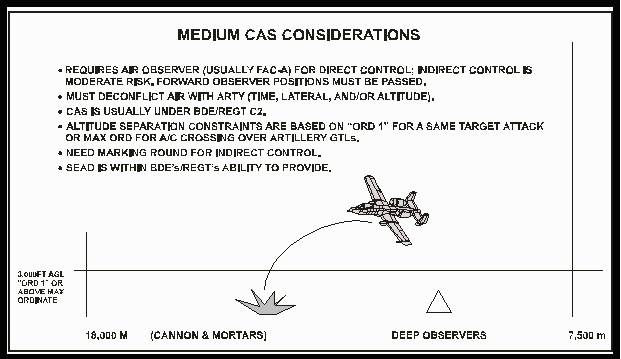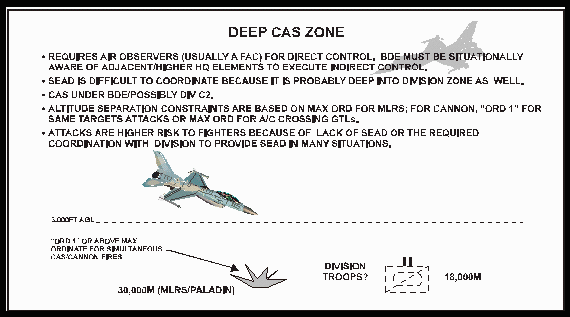CHAPTER 2
Defining the Army-Air Force 3-D Battlefield
This chapter provides an overview of the complexities associated with airspace coordination over and in front of a ground maneuver element, brigade-sized and below. The "3-D" Army - Air Force battlefield is a crowded piece of airspace with attack and lift aviation assets, unmanned aerial vehicles (UAVs), indirect fires, surface fires and fixed-wing assets from every service. Since the demise of battlefield aerial interdiction (BAI) from doctrine, the term CAS has taken on the battlespace short of the Fire Support Coordination Line (FSCL).
The question always asked by brigade commanders is, Where do I employ CAS? A good article to begin with is one written by Colonel Gary Buis, USAF, published in the Air Land Sea Bulletin (ALSA), December 1996, titled "Air Warrior/National Training Center, Now Verses Yesterday." In his article, Colonel Buis offers a method of sectoring the brigade airspace into three "CAS Zones," namely, Close, Medium, and Deep.
This chapter expounds on the Army's responsibilities within those three zones, with a focus on deconflicting aviation and ground assets/fires in the Close CAS Zone. We will start our discussion with the Close CAS Zone and work forward from the forward line of own troops (FLOT). (Note: Many of the ranges depicted on the following charts relate to weapons and training ammunition used at the NTC. They conform to various safety references and rules of engagement (ROE).)

What is the Close CAS Zone (CCZ)?
The Close CAS Zone presents the highest planning and execution challenges you will face while employing CAS. The CCZ is a non-doctrinal reference to the close-in fight, defined by the maximum direct fire weapon ranges of the ground maneuver element.
Of course, the range of this zone can vary greatly between a light infantry battalion and an armor battalion. At the NTC, we use the area defined by a M1A1 Tank 120-mm gun training round's Ricochet Danger Zone (RDZ) since this round produces the "worst case" ricochet hazards. The 120-mm RDZ is an area defined as 7.5 kilometers long and 5,000 feet high.
Areas outside these dimensions provide absolute protection from direct fire ricochets for fighters operating over a direct fire fight. To execute a CAS strike without shutting down maneuver element fires, it is imperative to define this protected air-battle space. Using the above RDZ logic, the NTC Close CAS Zone (CCZ) is the area in front of the FLOT out to 7.5 kilometers and above 5,000 feet. A fighter must stay outside and above this zone to avoid the effects of direct fires.
Execution of CAS within the CCZ is almost always a task force responsibility. Once the brigade decides where it will employ CAS (understanding that CAS planning by Air Force doctrine is centralized), the brigade TACP must task the task force air liaison officers (ALOs) and staffs to plan the CAS employment that will occur within their zones/sectors. Brigade TACPs usually are not in position to execute Direct Control missions. While the enemy target and CAS allocated to strike it may have been directed by the brigade commander, the task force TACP/FSE needs to clear it and control it in their sector. The contributing factor to numerous reported force-on-force CAS fratricides is that the brigade was controlling air strikes close to a task force/company team without direct control.
| Historical
Example of CAS Fratricide: The Korean War's Worst Incident.
"On September 22, a flight of Mustangs bombed and strafed the 1st Battalion, Argyll and Sutherland Highlanders, British 27th Brigade. Attacking during the Mustangs' errant strike, the North Koreans drove the Highlanders from their hill; enemy action and the accidental airstrikes killed and wounded seventy six Scouts. Although the [Mustangs] had obtained directions from both a FAC and a Mosquito [callsign for an airborne TAC], they had struck the wrong position. Fortunately, British high commanders in the Far East then regarded the mistake as merely regrettable. [Lt. Gen] Stratemeyer and [Maj. Gen.] Partridge appreciated the interallied understanding, doubting the American press would have been so kind had it known that the ground FAC had directed a strike seven miles from his position (emphasis added)." |
What is Required to Execute Air Strikes within the Close CAS Zone?
First, establish qualified Air Force ground terminal controllers in positions where they can execute missions using direct control procedures when releasing weapons, i.e., giving clearance to drop/fire. According to the Joint Publication 3-09.3, "Joint Tactics, Techniques, and Procedures for Close Air Support," positive control means the TACP is able to observe and control the attack. To the NTC, this means the TACP knows his ground forces' locations (usually he's collocated), sees the target area, and can observe the attacking aircraft with enough clarity to verify it is oriented on the target area. Forward Air Controllers-Air (FAC-As) can accomplish these requirements when aircraft are operating at medium and high altitudes. Experience has shown that if an aircraft visually augments his flight path, such as shooting off periodic flares, a ground TACP can distinguish fighter orientation between 6,000 and 8,000 feet above ground level (AGL). Above that altitude, it is almost impossible for ground FACs to verify fighter orientation. The FAC-A can accomplish these higher altitude attacks as long as he gets a target mark, can see the fighters, and can determine friendly force locations. Meeting these direct control conditions is harder than it seems; numerous attacks rapidly deteriorate to "indirect" control procedures and sometimes degenerate to "reasonable assurance" in numerous force on force battles, which is a leading cause of fratricides. (See notes for an explanation of indirect control and reasonable assurance (RA).)
Second, positively mark/identify friendly force locations. Currently there is not a single visual marking aid which works in a wide variety of METT-T situations. The "day-glo" orange panels, fire-fly lights, glint tapes and infrared pointers have a value in specific situations, but with aircraft making multiple passes or orbits over a target area to confirm friendly/enemy locations, it is obvious our maneuver forces still lack adequate marking aids. The need and ability to mark our locations quickly and effectively is not well addressed in doctrine, TTPs, and unit SOPs. In live-fire operations, units must often improvise marking aids when they get to the NTC to satisfy this basic fratricide prevention requirement. Night CAS amplifies this friendly marking problem even more. The proliferation of laser pointers, night-vision devices, and the washout caused by an intense fire fight/burning vehicles can compound the identification problem to the point that it becomes almost impossible to accomplish certain attacks.
Third, mark the target. History has shown that marking targets has dramatically increased the probably of first bombs on target and lessened the probability of fratricide. Target marks in the Close CAS Zone must be visual to the naked eye, can be delivered by numerous indirect fire systems or FAC-A rockets, and may be smoke, illumination, or clearly distinguishable high explosive munitions. Target marks provide the ground force observers the opportunity to confirm correct target location and orientation of fighters prior to weapons release.
The following illustration graphically depicts the Close CAS Zone with other considerations for planning and execution.

Where is the Medium CAS Zone (MCZ), and What Do I Have to Accomplish There?
The Medium CAS Zone begins at the end of the tank surface danger zones (7,500 meters (7.5 kilometers) from the maneuver FLOT), and extends out to about 18,000 meters (18 kilometers). The far end of the zone is actually determined by the types of Direct Support and Reinforcing battalions (DS/R) that are supporting the brigade.
The range of DS/R artillery beyond the FLOT determines a unit's ability to support CAS assets with SEAD or mutually attack targets. The 18-kilometer rule generally applies to all 155-mm, self-propelled artillery ranges and excludes special range augmentation munitions such as Rocket-Assisted Projectiles (RAPs), etc. Depending on the distance of the DS/R units behind the FLOT, RAP may be required to range 18,000 meters across the entire brigade sector/zone. For discussion clarity in this newsletter, 7.5 to 18 kilometers is used.
The MCZ is an ideal killing ground for fire support assets, providing good standoff ranges to execute triggers, opportunity to mass munitions over time, and plenty of airspace for fighters to maneuver through. The MCZ allows for massing of indirect and air support fires early on enemy forces to cause attrition, disruption, and delays in his battle scheme. This zone provides an opportunity for the brigade to mass on subsequent enemy echelons during the defense or offense to set favorable combat ratios for the task force close fights.
Terminal Control will almost always be Indirect (unless there is a FAC-A on station or a TACP integrated with reconnaissance or "deep eyes" missions). Once the FAC-A has identified friendly forces (i.e., scouts, COLTs, etc.) forward of the FLOT, he can then work Direct Control Procedures. The brigade will seldom have the opportunity to insert ground TACPs deep enough to meet these requirements without accepting tremendous survivability risks. Army doctrine tries to compensate for this by advocating that field artillery observers (COLTs) could provide indirect control assistance. In practice though, neither the Air Force nor the Army have a training program to train the necessary procedures to standard for artillery observers.
Marking friendly forces usually means using an appropriate day or night-time device to visually augment the forward observers, passing the NFAs to the fighters/FAC-A and associating observers with identifiable terrain. During night-time NTC live fires, the FAC-A or fighters will make a visual confirmation of all deep assets prior to being allowed to release ordnance.
Marking the target is no less important in these attacks. Remember--the benefit of marking a target is positive target identification; get the fighters to kill the right enemy. Do not simply call grids to the fighters and expect them to identify the correct enemy; the view from the air can be radically different from the ground. A FAC-A may see multiple enemy formations that are not visible from the ground so a mark could ensure he focuses on the correct enemy.
The following illustration graphically highlights some other planning and execution considerations for the staff to work through.

The Deep CAS Zone (DCZ) and its Purpose.
As mentioned in Colonel Buis's article published in the Air Land Sea Bulletin (ALSA), December 1996, titled "Air Warrior/National Training Center, Now Verses Yesterday," the term "Battlefield Aerial Interdiction (BAI)" is no longer in use. The Air Force uses only "Aerial Interdiction (AI)" and "CAS" in its doctrinal discussions of where to employ air power. CAS, as the primary air resource for the brigade, has a very large area with which to contend.
The Deep CAS Zone could be the area from 18km to 30km or the forward boundary of the FSCL. A good planning figure for range of the Multiple Launch Rocket System (MLRS) and the M109A6 Paladin with extended range munitions is 30,000 meters.
Missions flown in this zone could be "interdiction" for a brigade. In this zone, the enemy can be influenced several hours prior to direct fire contact. The command and control of these strikes is more challenging than it may first appear. The quality of the intelligence coming from higher/outside sources added to the limited ability of brigade assets to see that deep, generate some targeting confidence issues. The FAC-A must be well briefed to assist the brigade intelligence/targeting effort and find the right enemy formations. A thorough intelligence brief is paramount to achieving the desired payoff of using fighters in this zone.
Direct Control will almost certainly only come in the form of a FAC-A. If you must fly these missions under Indirect Control, you must double your efforts to verify the locations of adjacent and higher unit elements which are operating deep. Remember--these missions will plot close to the far end of the brigade zone or sector, probably beyond your CFL. In the course of pursuing a moving enemy, the attack may actually occur in the division zone where deep reconnaissance and cavalry squadrons may be operating.
Target marking will come in form of high explosive indirect fires or FAC-A smoke rockets. Army attack aviation working deep could provide valuable target intelligence, marking, artillery adjustments, and mutually supporting SEAD for the air strikes. Artillery coordination may take longer because of the distinct possibility of having to use division artillery assets to support the missions, rather than your own brigade assets. As with the Medium CAS Zone, this zone will also contain the enemy's artillery assets which are the prime targets of friendly counterfire operations. This creates a high demand for coordination between CAS and artillery due to the counterfire fire battle demands.
The following illustration of the Deep CAS Zone shows some additional issues for planning and execution.

CONCLUSION AND NOTES
In the discussion of the Close, Medium, and Deep CAS Zones, we have highlighted the critical risk factors associated with training ammunition used at the NTC. During peacetime we develop standoff distances and ROE which tolerates no risk, keeping with the principle that there is no training worth life or limb to execute. In wartime we must factor in some risk to facilitate execution of missions. Study of Army Regulations 385-62 and 385-63, Policies and Procedures for Firing Ammunition for Training, Target Practice, and Combat, should be mandatory for all leaders. Joint Pub 3-09.3, JTTP for the Employment of Close Air Support, is an excellent start point to develop the staff's knowledge of CAS operations. Another good source of "wartime" considerations is the article "Risk Estimate Distances (REDs) for Indirect Fires" in the April-May 1997 issue of Field Artillery. (NOTE: The "REDs" article for artillery is based on indirect fires impacting perpendicular to the FLOT, whereas CAS ordnance "REDs" are based on bomb patterns which are parallel to the FLOT). These ammunition data used in conjunction with sound doctrinal graphic control measures (boundaries, air corridors, FSCMs, etc.) can ensure we employ sound fratricide prevention measures.
We also discussed "Indirect Control" and "Reasonable Assurance." These are defined within the Joint Pub 3-09.3, JTTP for the Employment of Close Air Support. However, the Joint Pub does not illuminate the considerations a Joint Force Commander must understand to allow "Reasonable Assurance (RA)" attacks. The fratricide discussions within the Close CAS Zone provide a great point of departure for listing those necessary considerations a commander must address to ensure ground forces safety, i.e., troop marking, target marking, relative location of friendly troops to target, criticality of the target, etc. For example, if I can't see the aircraft, then what electronic or visual methods can be employed to
Another way to consider an RA attack is to complete the phrase "I am reasonably sure we will not bomb friendly troops because.." Remember--RA greatly increases the risk of fratricide because there is no fail-safe friendly identification system. RA should only be used in cases where the target must be struck because it is critical to mission success. Unfortunately, the trend has been to execute RA-type attacks by default rather than design, and the relative risks have not been understood by the ground units.
CHAPTER SUMMARY
This discussion has focused on a method for dividing up the airspace in front of the Brigade Combat Team to identify those critical requirements necessary to execute safe, effective air strikes. This TTP is for reference only--current NTC ROE "rules the desert." Some have suggested dividing the battle space into just "Close" and "Deep" CAS, which is just as valid.
We must understand the risk factors associated with any air strike, fixed wing or helicopter.
|
NEWSLETTER
|
| Join the GlobalSecurity.org mailing list |
|
|
|

